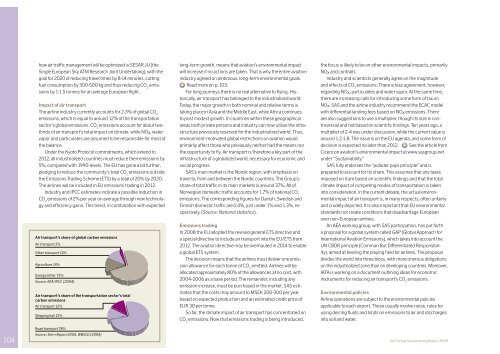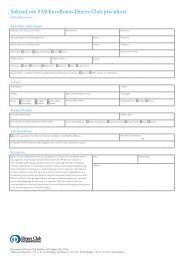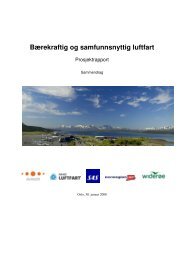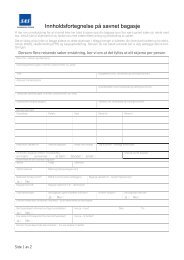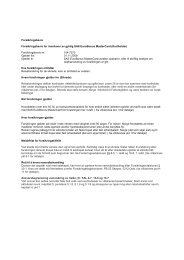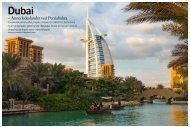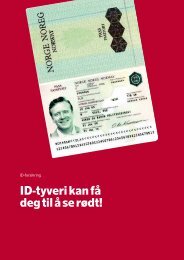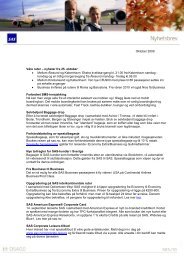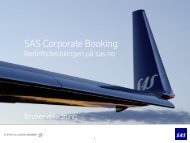Sustainability Report We're reducing our climate impact for ... - SAS
Sustainability Report We're reducing our climate impact for ... - SAS
Sustainability Report We're reducing our climate impact for ... - SAS
You also want an ePaper? Increase the reach of your titles
YUMPU automatically turns print PDFs into web optimized ePapers that Google loves.
how air traffic management will be optimized is SESAR JU (theSingle European Sky ATM Research Joint Undertaking), with thegoal <strong>for</strong> 2020 of <strong>reducing</strong> travel times by 8-14 minutes, cuttingfuel consumption by 300-500 kg and thus <strong>reducing</strong> CO 2emissionsby 1-1.5 tonnes <strong>for</strong> an average European flight.Impact of air transportThe airline industry currently accounts <strong>for</strong> 2-3% of global CO 2emissions, which is equal to around 12% of the transportationsector’s global emissions. CO 2emissions account <strong>for</strong> about twothirdsof air transport’s total <strong>impact</strong> on <strong>climate</strong>, while NOx, watervapor and particulates are assumed to be responsible <strong>for</strong> most ofthe balance.Under the Kyoto Protocol commitments, which extend to2012, all industrialized countries must reduce their emissions by5%, compared with 1990-levels. The EU has gone a bit further,pledging to reduce the community’s total CO 2emissions outsidethe Emissions Trading Scheme (ETS) by a total of 20% by 2020.The airlines will be included in EU emissions trading in 2012.Industry and IPCC estimates indicate a possible reduction inCO 2emissions of 2% per year on average through new technologyand efficiency gains. This trend, in combination with expectedAir transport’s share of global carbon emissionsAir transport 2%Other transport 12%Agriculture 14%Energy/other 72%S<strong>our</strong>ce: EEA/IPCC (2004)Air transport’s share of the transportation sector’s totalcarbon emissionsAir transport 12%Shipping/rail 12%long-term growth, means that aviation’s environmental <strong>impact</strong>will increase if no actions are taken. That is why the entire aviationindustry agreed on ambitious, long-term environmental goals.Read more on p. 103.For long j<strong>our</strong>neys there is no real alternative to flying. Historically,air transport has belonged to the industrialized world.Today, the major growth in both nominal and relative terms istaking place in Asia and the Middle East, while Africa continuesto post modest growth. In countries within these geographicalareas both private persons and industry can now utilize the infrastructurepreviously reserved <strong>for</strong> the industrialized world. Thus,environment-motivated global restrictions on aviation wouldprimarily affect those who previously neither had the means northe opportunity to fly. Air transport is there<strong>for</strong>e a key part of theinfrastructure of a globalized world, necessary <strong>for</strong> economic andsocial progress.<strong>SAS</strong>’s main market is the Nordic region, with emphasis ontravel to, from and between the Nordic countries. The Group’sshare of total traffic in its main markets is around 37%. All ofNorwegian domestic traffic accounts <strong>for</strong> 1.7% of national CO 2emissions. The corresponding figures <strong>for</strong> Danish, Swedish andFinnish domestic traffic are 0.4%, just under 1% and 1.3%, respectively.(S<strong>our</strong>ce: National statistics).Emissions tradingIn 2008 the EU adopted the revised general ETS directive anda special directive to include air transport into the EU/ETS from2012. The aviation directive may be overhauled in 2014 to enablea global ETS system.The decision means that the airlines must deliver one emissionallowance <strong>for</strong> each tonne of CO 2emitted. Airlines will beallocated approximately 80% of the allowances at no cost, with2004-2006 as a base period. The remainder, including anyemission increase, must be purchased in the market. <strong>SAS</strong> estimatesthat the costs may amount to MSEK 200-300 per yearbased on expected production and an estimated credit price ofEUR 30 per tonne.So far, the <strong>climate</strong> <strong>impact</strong> of air transport has concentrated onCO 2emissions. Now that emissions trading is being introduced,the focus is likely to be on other environmental <strong>impact</strong>s, primarilyNOx and contrails.Industry and scientists generally agree on the magnitudeand effects of CO 2emissions. There is less agreement, however,regarding NOx, particulates and water vapor. At the same time,there are increasing calls <strong>for</strong> introducing some <strong>for</strong>m of tax onNOx. <strong>SAS</strong> and the airline industry recommend the ECAC modelwith differential landing fees based on NOx emissions. Thereare also suggestions to use a multiplier, though its size is controversialand not based on scientific findings. Ten years ago, amultiplier of 2-4 was under discussion, while the current value isaround 1.2-1.8. The issue is on the EU agenda, and some <strong>for</strong>m ofdecision is expected no later than 2012. See the article fromCicero on aviation’s environmental <strong>impact</strong> at www.sasgroup.netunder “<strong>Sustainability</strong>.”<strong>SAS</strong> fully endorses the “polluter pays principle” and isprepared to account <strong>for</strong> its share. This assumes that any taxesimposed on it are based on scientific findings and that the total<strong>climate</strong> <strong>impact</strong> of competing modes of transportation is takeninto consideration. In the current debate, the actual environmental<strong>impact</strong> of air transport is, in many respects, often unfairlyand crudely depicted. It is also important that EU environmentalstandards not create conditions that disadvantage Europeanover non-European airlines.An AEA working group, with <strong>SAS</strong> participation, has put <strong>for</strong>tha proposal <strong>for</strong> a global system called GAP (Global Approach <strong>for</strong>International Aviation Emissions), which takes into account theUN CBDR principle (Common But Differentiated Responsibility),aimed at leveling the playing field <strong>for</strong> airlines. The proposaldivides the world into three blocs, with more onerous obligationson the industrialized zone than on developing countries. Moreover,IATA is working on a document outlining ideas <strong>for</strong> economicinstruments <strong>for</strong> <strong>reducing</strong> air transport’s CO 2emissions.Environmental policiesAirline operations are subject to the environmental policiesapplic able to each airport. These usually involve noise, rules <strong>for</strong>using deicing fluids and limits on emissions to air and dischargesinto soil and water.104Road transport 76%S<strong>our</strong>ce: Stern <strong>Report</strong> 2000, WBSCD (2004)<strong>SAS</strong> Group <strong>Sustainability</strong> <strong>Report</strong> 2009


